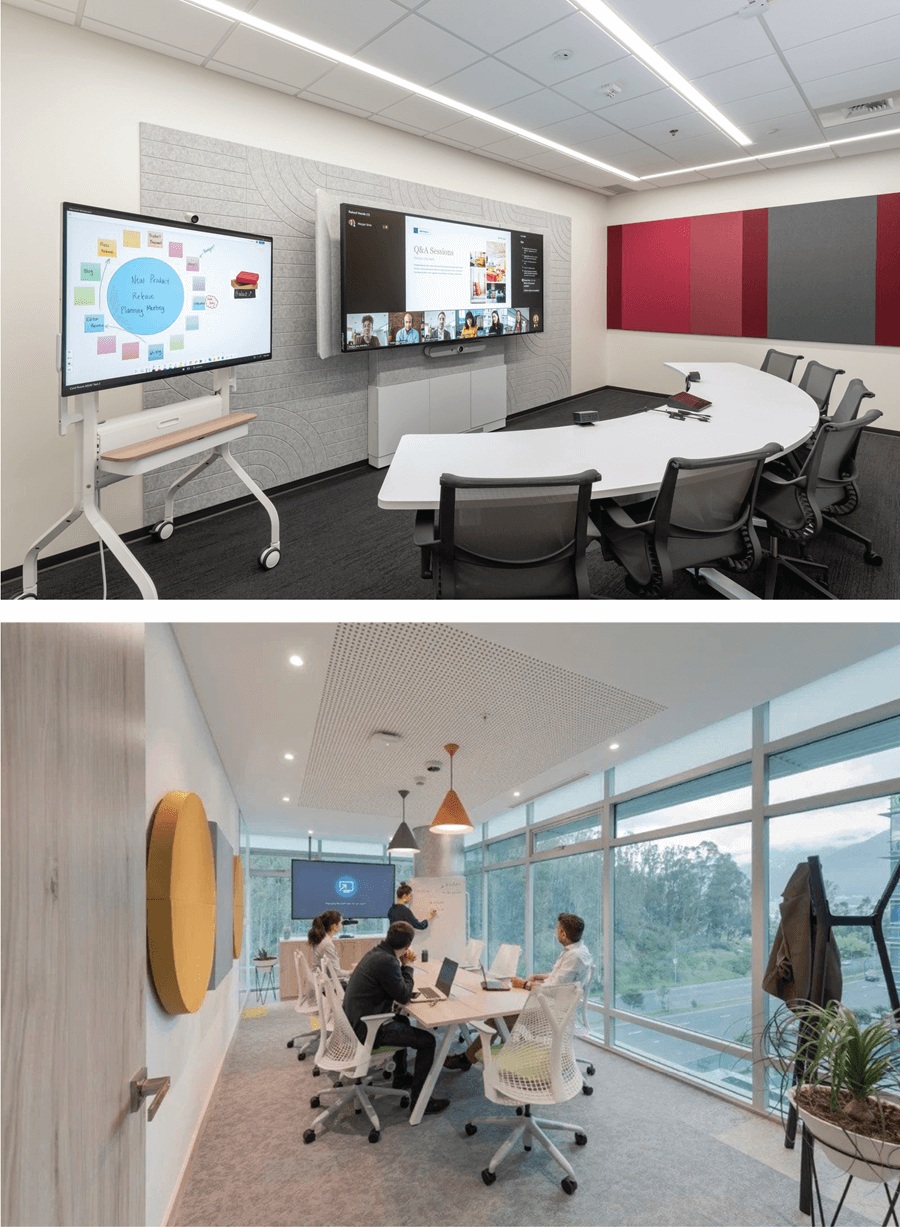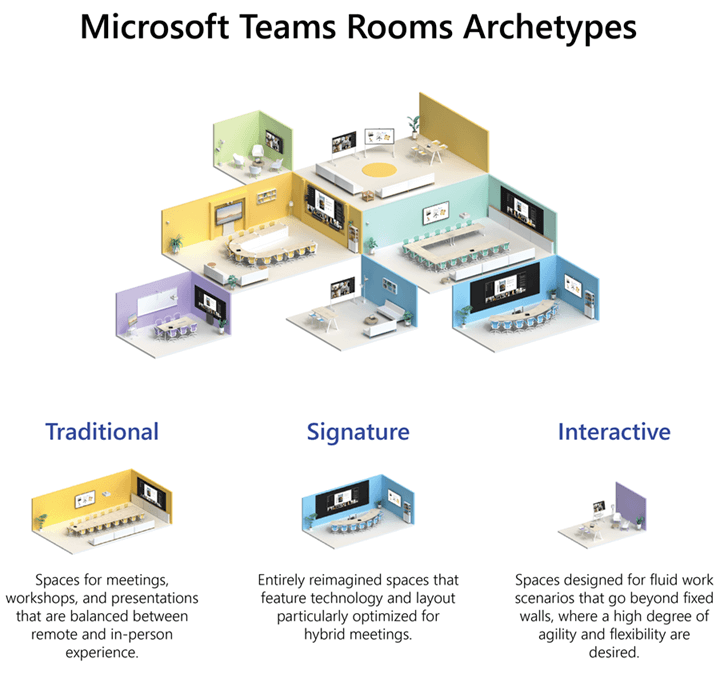 “Phygital” (physical plus digital) is a marketing term that’s often used to describe the blending of digital experiences with physical ones. As employees’ and customers’ ways of interaction proliferate, companies aim to seamlessly integrate them. Nothing has been impacted more by the phygital than the way in which we now work and how we collaborate, influence, and make connections with our colleagues and customers.
“Phygital” (physical plus digital) is a marketing term that’s often used to describe the blending of digital experiences with physical ones. As employees’ and customers’ ways of interaction proliferate, companies aim to seamlessly integrate them. Nothing has been impacted more by the phygital than the way in which we now work and how we collaborate, influence, and make connections with our colleagues and customers.
At Microsoft, hybrid work is a way of life and it’s how our employees and partners will continue to innovate. With more than 220 thousand full-time employees and 100 thousand vendors across 150 geographies, 24 different time zones, over 580 Microsoft office buildings worldwide, and an abundance of additional remote and home office locations—all of which are using a myriad of technological devices and applications—no one is more immersed in the realities of a phygital or hybrid working world than we are.
And while a flexible, hybrid working environment continues to be a competitive advantage for many companies and their employees, it’s critical that their physical environment and workspace experiences adapt and evolve to meet this new norm.
With so many companies, including Microsoft, operating in a hybrid work world, now is the time to reimagine our meeting room experiences and make sure they are optimal and inclusive for all participants, whether they are in person or remote.
— Nathalie D’Hers, corporate vice president, Microsoft Digital
Hybrid is here to stay but the workplace remains the critical place for collaboration
At Microsoft, we’ve dedicated an entire team of designers, engineers, and researchers comprised of folks from Microsoft Digital (Microsoft’s IT organization), Global Workplace Services (GWS), and the Microsoft Teams product group to think through our new phygital reality and ensure that we’re creating work environments for our employees and customers that make sense now and into the future.
“With so many companies, including Microsoft, operating in a hybrid work world, now is the time to reimagine our meeting room experiences and make sure they are optimal and inclusive for all participants, whether they are in person or remote,” says Nathalie D’Hers, corporate vice president of Microsoft Digital.
Going forward, we know that it’s imperative that companies ensure that every meeting space is enabled for hybrid work success. With that said, no one understands how daunting, expensive, and time-consuming it is to upgrade spaces more than the team here at Microsoft that’s responsible for solving that challenge. That’s why they’re taking out some of the guesswork for our customers and helping them approach the issue head on. Whether they’re optimizing experiences for new construction or remodeling existing spaces with updated capabilities, the team is focused on helping customers figure out the smartest and most efficient ways to invest in their workspaces.
The Hive affords us the ability to ‘try-storm’ if you will, which is a combination of brainstorming and rapid prototyping to quickly determine if our ideas will work or not. This helps the team get to resolution faster and ensures that we produce workplace solutions that will be a value-add for our employees straight out of the gate. We’re also helping our customers by removing the guess work for them and providing a significant blueprint to save them time and resources.
— Matthew Marzynski, principal product manager, Microsoft Digital

‘Thinking through making’ to help alleviate much of the guesswork
By now, you’ve probably heard about Microsoft’s on-campus workplace innovation laboratory, The Hive. The Hive is a critical space and the think tank for our team to solve for some of these workspace challenges and opportunities. Companies like Boeing have long used warehouses dedicated to mocking up the interiors of aircraft at full scale to better understand how to solve physical space, engineering, and experience design challenges, and The Hive has become that space for Microsoft.
As a design expert who worked in the aerospace industry, Matthew Marzynski, a principal product manager with Microsoft Digital, knows all too well the importance of having a space like The Hive to allow the art of “thinking through making,” a process in which making and thinking alternate back and forth constantly, in rapid iterations, and when the making or designing is taking place intuitively. The Hive provides this necessary playground, allowing for a diverse group of thinkers and doers to share ideas and rapid prototype “what if” concepts, and where these ideas often lead to business-critical outcomes.
“The Hive affords us the ability to ‘try-storm’ if you will, which is a combination of brainstorming and rapid prototyping to quickly determine if our ideas will work or not,” Marzynski says. “This helps the team get to resolution faster and ensures that we produce workplace solutions that will be a value-add for our employees straight out of the gate. We’re also helping our customers by removing the guess work for them and providing a significant blueprint to save them time and resources.”
Creating a holistic experience for all participants
So, what’s been the focus in The Hive as of late? The team there is working on ensuring that Microsoft is creating exceptional workspace experiences that put the phygital at the forefront, and make attending meetings worthwhile for all employees, whether they’re working from the office or remotely. This includes redesigning meeting room spaces to be less table-centric (i.e. the generic, large conference table in the middle of the room that everyone is expected to gather around). This traditional setup is a byproduct of pre-pandemic times when most of the workforce attended in-office meetings and there was little thought put into making these spaces feel inclusive.

But we know that it’s not enough to just improve the in-room layout, it’s also imperative that these spaces are more hybrid-friendly, which means incorporating the right mix of technology, spatial audio, and design elements to create a more holistic and enhanced experience.
“A meeting space should have the same ‘feeling’ as a well-engineered movie theatre experience, where participants do not notice the technology, the audio equipment or acoustics, the furniture or theatre’s design while they are in the space. In fact, it’s not until they walk out of the room that perhaps, subconsciously, they might recognize those things in harmony added to the enjoyment of their experience,” Marzynski says.
And it’s this harmony that the team is looking for in concepts in-progress at The Hive. Where their solutions result in true integration and a sense of inclusion, and where all colleagues, whether they’re physically sitting next to each other in the room, or participating from a remote location, are perceived as equals.
We simply cannot redesign and transform every space into a Signature showcase room with new furniture, new technology, etc. Instead, we are innovating and reducing cost and complexity at scale. With the Teams platform and strategic investments, we can still accomplish a powerful, productive hybrid experience with minimal amount of impact to existing, traditional rooms with boring furniture.
— Sam Albert, principal product manager, Microsoft Digital
A great example of some of the workspace solutions to come from The Hive, includes the new Microsoft Teams Rooms Signature Boardroom experience, a reimagined executive boardroom that’s now being used by Microsoft’s senior leadership, including CEO Satya Nadella. This new Boardroom experience provides the best possible scenario for in-person and hybrid, by using a specific layout, furniture and finishes, spatial audio, and the latest Teams technology to create a more immersive experience, taking remote attendees from being merely observers of a meeting to engaged, active participants.

We realize that there are certain high value spaces, like Signature Rooms and Boardrooms, where Microsoft and other companies are willing and able to fully optimize for the best hybrid experience and that these projects will come at a higher cost, specifically in a retrofit scenario versus new construction. By aiming to reduce costs and have the highest impact across an entire workspace portfolio, tradeoffs will need to be made.
“We simply cannot redesign and transform every space into a Signature showcase room with new furniture, new technology, etc. Instead, we are innovating and reducing cost and complexity at scale,” says Sam Albert, a principal product manager in Microsoft Digital. “With the Teams platform and strategic investments, we can still accomplish a powerful, productive hybrid experience with minimal amount of impact to existing, traditional rooms with boring furniture.”
We’re helping Microsoft, and our customers, maximize their real estate portfolios by creating agile spaces that can be deployed quickly and cost-effectively to help make the best use of these large spaces.
— Roy Sherry, principal product manager, Microsoft Digital
The cost of getting it right
Companies, especially Fortune 50 enterprises, are spending billions of dollars annually on their real estate footprint, with large meeting rooms and event spaces being among the most expensive to build and operate. That’s why The Hive team is looking to reduce the cost of meeting rooms by up to 75 percent over the next year. One of the ways they aim to do this is by creating more flexible and scalable spaces that can be used for different scenarios.

“All-hands meetings, training sessions, senior leadership gatherings, recognition and culture activities all tend to take place in larger spaces but can have very different needs and requirements,” says Roy Sherry, a principal product manager in Microsoft Digital. “We’re helping Microsoft, and our customers, maximize their real estate portfolios by creating agile spaces that can be deployed quickly and cost-effectively to help make the best use of these large spaces.”
That’s why multi-purpose event rooms are part of The Hive’s next order of business. With these types of large-scale spaces costing companies hundreds of thousands of dollars to deploy, it’s critical that they’re optimized with the products and solutions that will provide the most amount of flexibility, that align the physical space with the best digital capabilities, and that will stand the test of time.
For customers wanting to get a more detailed understanding and behind-the-scenes look at the work being done in The Hive, in addition to their customer tours of the space.
The bottom line is that many companies need to start rethinking how their real estate is being used, specifically their workspaces and conference rooms, before millions are wasted. And one of the best, most cost-effective ways to do so is by using the Teams Rooms archetypes and specifications that The Hive has created for Microsoft as Customer Zero. These archetypes are agile and adaptable to customers’ spaces, helping to make real estate and technology investments that are durable and tuned to evolving workplace needs.
Microsoft and the team at The Hive are here to lead the way and help customers get the most out of the new phygital workplace reality, ensuring that conference spaces and meeting room experiences are aligned to these new expectations. By making the best use of Microsoft Teams (digital) and combining it with the right hardware, infrastructure, furniture, audio, and finishes (physical), your workplace will be transformed and at its full potential.
Here are some suggestions for rethinking your physical and digital spaces:
- Embrace the phygital reality: You should aim to seamlessly integrate digital experiences with physical ones to adapt to the new norm of hybrid work. This includes ensuring that every meeting space is enabled for hybrid work success and that the physical environment and workspace experiences evolve to meet the needs of a flexible, hybrid working environment.
- Invest in workspace optimization: Upgrading workspaces to meet the demands of hybrid work can be daunting, expensive, and time-consuming. However, it’s imperative for you to invest in your workspaces in the smartest and most efficient ways, whether that means optimizing experiences for new construction or remodeling existing spaces with updated capabilities.
- Innovate through collaboration: You can benefit from bringing together a diverse group of thinkers and doers, such as designers, engineers, and researchers, to collaborate and solve workspace challenges and opportunities. This can be achieved through the creation of dedicated spaces, such as Microsoft’s on-campus workplace innovation laboratory, The Hive, where ideas can be shared, rapid prototyping can take place, and business-critical outcomes can be achieved through the art of thinking through making.
Here’s where you can go to try Microsoft Teams Rooms for free.

Want more information? Email us and include a link to this story and we’ll get back to you.







